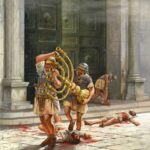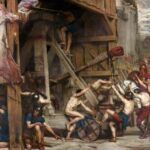As we already know, the religion of the Romans was strongly influenced by the Greeks and Etruscans. So at the very beginning, we will say that there was polygamy in Ancient Rome. At the very beginning, it was a nonpersonal religion, typically agricultural, in which things related to the role, such as sowing and harvesting, were worshipped.
In addition to agricultural deities, house idols were also worshipped:
- Lares – keepers of the household
- Manes – ancestral spirits
With time, the state introduced state cults. The deities acquired anthropomorphic, or human, features. The main deities came to be considered: Jupiter, Juno and Minerva, forming the Capitoline Trinity. The holiest place was chosen the temple of the Best and Greatest Jupiter, located on the Capitol. Other trinity deities were also worshipped there. The Romans also solemnly worshipped the goddess Vesta – the home guardian of the fire. Soon the cult of the goddess Vesta took on a national character because as the goddess of the holy fire, she was also the patron of the Roman Empire. The fire was to burn constantly in her temple in the Forum Romanum. In the temple, priestesses – Vestals watched over the holy fire.
In Rome, everyone had to obey the worship of state gods, and in the event of not subordination, severe punishments were imposed on them, even on officials. An inseparable element of the Roman religion was divination, which gained immense popularity in Rome.
As you surely remember, the Romans were characterized by great tolerance for the religions of the conquered countries. They took over some patterns and deities, worshipping them as their own. The temple where all gods were prayed for was the Pantheon. It was built in the times of Augustus, which became a symbol of the unification of the Roman religion.
With time, eastern cults spread, and particular veneration was given to, for example, Isis and Osiris (Egypt). Already in the times of the republic, Cybele (the Asian goddess of fertility) was accepted into the group of national deities.
Prognostikon
In ancient times, many oracles were found throughout the empire. They were very widespread and famous. In the same way, the so-called A prognosticon. The magic Pergamon disc consists of three rings surrounding the inner field and is also divided into 32 compartments – symbolic groups. The twenty-four compartments on the outer rings are covered with numerous, ambiguous signs representing the material, spiritual and intellectual world. In the compartments of the outermost ring, ideograms relating to the world of things can be discerned.
The following rings, closer to the centre, contain Greek letters, characters similar to Egyptian hieroglyphs, and magic characters. The magician of Pergamon, before asking the oracle questions, chanted the appropriate invocations and thus put himself in a trance. In order to be able to take advantage of the oracle’s advice, or – as we call it today – to communicate with one’s higher self, the pendulum held over the Prognosticon was used. Originally, the pendulum certainly had the shape of a ring suspended on a thread, in keeping with ancient tradition. The magician read the answer from the letters and signs indicated by the pendulum.
In the era of the empire, the cult of the ruler and members of his family also appeared. Every citizen had to worship the emperor, regardless of whether he respected him or not. It was this duty that caused the rebellion of the Jews. They organized two uprisings. The first (66 – 73 CE), which caused the Romans to destroy the Temple of Jerusalem after the defeat of the Jews, and the second (132 – 135 CE), which caused the expulsion of Jews from Judea. It was then that the moment of dispersing the Jews throughout Europe began, otherwise known as diaspora.
Finally, it is worth discussing human sacrifice. Perhaps no civilization was free from it. Also the Romans. Livius writes about it in his work “Ab urbe condita”: in 216 BCE after the defeat at Cannae, extraordinary sacrifices were made. Two couples were buried alive at the forum – a Gallic and a Greek one. Apparently, similar events were supposed to have happened before. Pliny states in the “Natural History” that this practice was finally forbidden by the Senate in 97 BCE.






